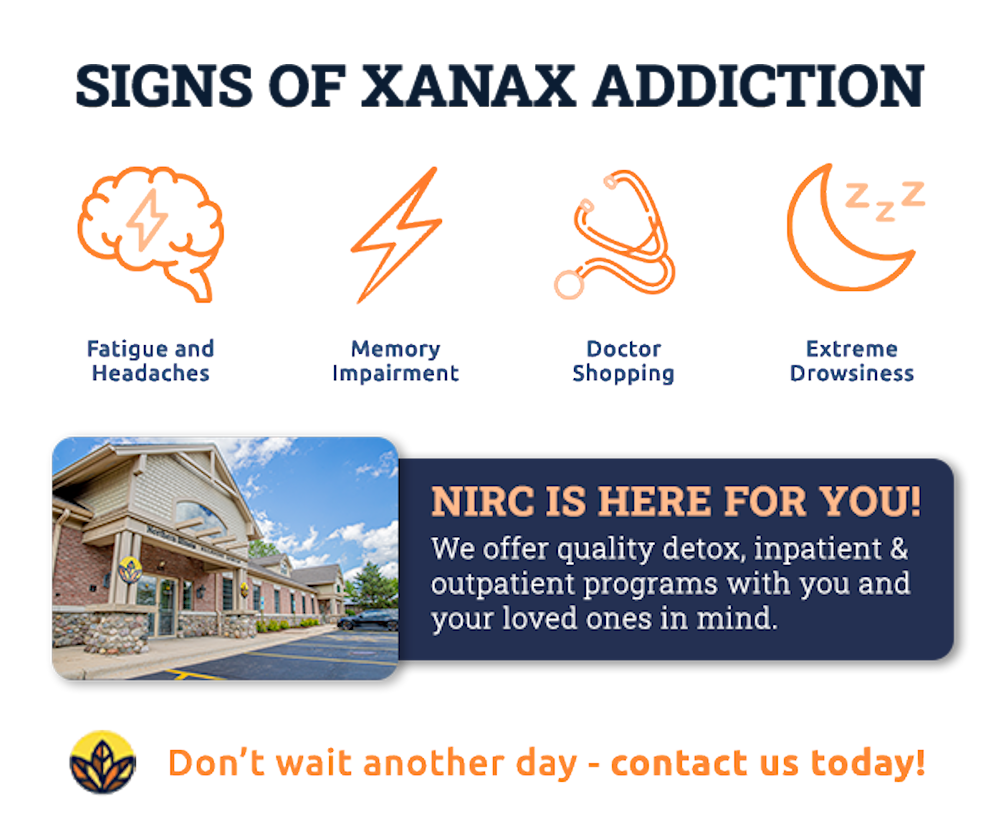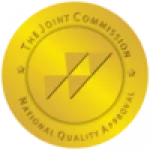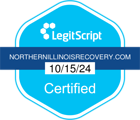Addiction can lower your quality of life and increase your chances of experiencing serious medical and mental health problems. Prescription medications like Xanax are prone to abuse and can cause physical dependency. Help from a Xanax addiction rehab center is typically needed to fully recover from the physical, cognitive, and emotional impact caused by addiction.
Substance abuse disorders have reached epidemic levels in the United States, causing drug overdoses to become the leading cause of accidental death. Young adults have been hit especially hard, with drug overdoses doubling over the past ten years and becoming the overall leading cause of death among 18 to 25-year-olds. At Northern Illinois Recovery Center, we offer a wide range of substance abuse treatment programs, including Xanax addiction rehab.
In large amounts, Xanax can cause a fatal overdose. It is also very dangerous to mix Xanax with other substances, especially other central nervous system depressants. You can stop breathing when you take Xanax in combination with alcohol or opiates.
Xanax is also physically addictive. Even if you take Xanax exactly as prescribed, you can develop a physical dependency, which is why Xanax is only recommended for short-term use. For these reasons, you may need a partial hospitalization program in Northern IL for this reason.
How Does Xanax Work?
What Are the Side Effects of Xanax?
Even though alprazolam is one of the most commonly prescribed benzodiazepines in the United States, there are still numerous side effects that are associated with it. If you are taking Xanax, you might experience some of the following:
- Memory impairment
- Depression
- Headache
- Dizziness
- Dysarthria (slow or slurred speech)
- Fatigue or drowsiness
Even though it’s normal to experience a few side effects when taking Xanax, make sure to check in with your doctor first.

What Are the Signs and Symptoms of Xanax Abuse?
- Asking friends, family, classmates, significant others, and/or colleagues for their Xanax pills
- Purchasing Xanax or other sedatives on the street
- Doctor shopping to gain extra Xanax pills
- Poor motor coordination
- An inability to reduce intake
- Slurred speech
- Extreme drowsiness
The withdrawal process from Xanax after an individual engages in sustained use can be specifically dangerous. There is a powerful recommendation that an individual receives assistance from a professional program, such as detox at a Xanax rehab center. Once Xanax abuse begins to progress, it can transition into what mental health professionals call an anxiolytic use disorder, or sedative-hypnotic.
This term derives from the Diagnostic and Statistical Manual of Mental Disorders, 5th edition (DSM-5), which is a reference book that is considered vital to the mental health community. Some of the earlier editions of the DSM-5 distinguished between physical dependence and addiction. However, the DSM-5 consolidated these concepts into a substance use disorder categorization.
How Does Xanax Addiction Start?
Physical dependency develops for an individual over time as the person’s body becomes used to the substance. Without the substance, the individual might begin to feel achy all over their entire body as it starts filtering the substance out. The discomfort the person might begin to feel can be treated with mild over-the-counter pain relievers.
The side effects, among many others, are considered to be common circumstances that land many in the emergency room when they attempt to detox at home instead of a treatment center. There were 44,796 individuals last year who were treated in American emergency rooms for matters deriving from the use and abuse of benzodiazepines such as Xanax.
What Is Detox?
It can take a detox process days or even months, to get past withdrawal symptoms for the majority of the drugs. The length of withdrawal depends on several factors, including:
- Method of abuse (smoking, injecting, swallowing, and snorting)
- The type of substance that the user is addicted to
- Underlying medical conditions
- The duration of the addiction lasted
- Amount of substance taken
- Family history
Insurance Verification




How Long Does Detox Take?
There are other drugs such as benzodiazepines that require a lengthier detox timetable, such as two weeks or more. The actual time it takes to eliminate the harmful substances from a person’s body is typically less important than actually making long-term changes to guarantee the user won’t relapse. Also, any recurring triggers can instead be managed effectively.
Both outpatient and inpatient Xanax addiction rehab programs can assist individuals who are struggling with drug and alcohol use. Xanax rehab centers can help people recover rapidly and comfortably while teaching healthy coping strategies. These coping strategies will enable the patients to be able to weather any displeasing physical or mental symptoms later on.
The Process of Detoxification
It’s important to remember that every person’s detox process is different. The drug detox process assists individuals with addictions in getting individualized treatment. In the majority of the cases, the process typically involves the following steps:
The medical team located at the Xanax addiction rehab screens the incoming patients for mental and physical health issues. Doctors utilize blood tests to measure the actual amount of drugs in the patient’s system. Overall, this helps determine the level of the medications that will be needed. There is also an inclusive review of medical, psychiatric, and drug histories. The information sets up the overall basis for the patient’s long-term plan.
Secondly, the next step is to stabilize the patient with psychological and medical therapy. The overall goal of stabilization is to prevent any form of harm from coming to the patient. Doctors can prescribe any additional addiction treatment medications to reduce withdrawal symptoms and prevent any further complications.
The final step of the detox process at Xanax addiction rehab is preparation for the treatment program. Doctors familiarize their patients with the treatment process and on what to expect. The inpatient rehab offers the most ideal chances of success after the detox program.
What Are the Side Effects of Detox?
A medically supervised detox program prevents threatening drug and alcohol withdrawal complications. Although medical detox restricts withdrawal symptoms, some are inevitable. The most common side effects of detox at Xanax rehab centers are:
- Body discomfort
- Mood swings
- Poor sleep
- Insomnia
- Nausea
- Difficulties concentrating
- Anxiety or nervousness
Withdrawal Symptoms from Xanax Addiction
- Nausea, vomiting, and cramps
- Depression and suicidal ideation
- Anxiety
- Insomnia and exhaustion
- Seizures and tremors
Xanax withdrawal symptoms can begin within 24 hours of your last use and typically alleviate within one week. The severity of withdrawal makes it difficult to recover without the help of a Xanax addiction rehab center Crystal Lake, Il offers.
What Are the Treatment Options at our Xanax Rehab Center in Illinois
The goal is to have our clients safe and comfortable during detox. Withdrawal should never be attempted alone because of the risk of seizures and relapsing. The final part of the Xanax treament process will involve addressing the mental damage caused by the addiction itself.
According to the Journal of Clinical and Consulting Psychology, cognitive behavioral therapy (CBT) has shown the most considerable amount of effectiveness in assisting clients to completely taper off of benzodiazepines. Cognitive behavioral therapy is a system of counseling that a client is assisted in seeing how their thoughts and behaviors patterns led to their Xanax addiction and abuse. As the therapist works closely with the client, they will be able to discover more positive and healthier ways of dealing with the root issues behind the Xanax addiction.
What our Xanax Rehab in Illinois Offers
Inpatient programs offer you the highest level of care, making it an ideal choice if you have a severe addiction. Many inpatient centers offer detox and addiction aftercare programs, as well as referrals to outpatient providers. You can choose to attend either a short-term or long-term Xanax addiction treatment center. Short-term programs usually last for no more than 28 days. Long-term residential care programs can offer treatment for 90 days or more.
Outpatient programs allow you to return home each night. A partial hospitalization program northern Il offers provides the highest level of outpatient care. Some partial hospitalization programs also provide detox services.
Intensive outpatient programs are less time-intensive but allow you to continue working or going to school during treatment. You can continue individual counseling after your treatment at a Xanax addiction treatment center, then transition to sober living and attend group therapy. Peer-led support groups like AA, NA, and SMART Recovery provide access to a strong support network during recovery.
Finding Treatment Today at Northern Illinois Recovery Center
- Alcohol Addiction Rehab
- Barbiturate Addiction Rehab
- Benzo Addiction Rehab
- Cocaine Addiction Rehab
- Heroin Addiction Rehab
- Meth Addiction Rehab
- Opiate Addiction Rehab
- Opioid Addiction Rehab
- Prescription Drug Addiction Rehab
Call us today to learn more about your treatment options if you are ready to begin recovery.




